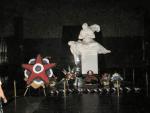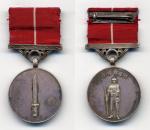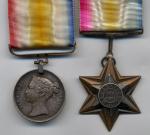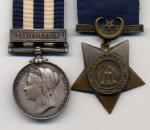-
Posts
14,343 -
Joined
-
Last visited
-
Days Won
25
Content Type
Profiles
Forums
Blogs
Gallery
Events
Store
Everything posted by Ed_Haynes
-

Soviet Soviet & Eastern Block Quiz
Ed_Haynes replied to Christophe's topic in Russia: Soviet: Other Militaria
I, too, was sadly struck that almost everything on display at the CMGPW was a (bad and nasty) fake. All I saw fake at the Armed forces museum were Zhukov's awards and I can, I guess, understand that?? Shall work on a puzzle. Don't want to make it one of those "how many fingers am I holding up" puzzles. -

Soviet Hierarchy of Soviet Awards?
Ed_Haynes replied to Christian Zulus's topic in Russia: Soviet Orders, Medals & Decorations
I decline to engage in ad hominem[ attacks, preferring "research at twenty paces at dawn". An interesting topic has run its course, as far as I am concerned. And I am not now, nor have I ever been, British. My ancestors were Scots, having been thrown out a mere twenty years later they could have been Australians. -

Soviet Hierarchy of Soviet Awards?
Ed_Haynes replied to Christian Zulus's topic in Russia: Soviet Orders, Medals & Decorations
I shall henceforth ignore this thread. -

My New WW2 Commonwealth Stars
Ed_Haynes replied to Avitas's topic in Great Britain: Orders, Gallantry, Campaign Medals
Sorry for getting this . . . . We need to distinguish three populations of pre-1947 "Indian Army": 1- Those who went to India (including the Gorkha regiments and Gorkha personnel who stayed in the Indian Amry) received their medals mostly but not entirely named (maybe 85%?) about 1952-55 (I am trying to refine this chronology and the conditions for named/unnamed). An all-unnamed Indian group is rare (and usually has a tale behind it), while a 100%-named group is not common. See some of the groups I have posted. (These were made and named in the Calcutta mint.) 2- Those who went to Pakistan (many of the pre-1947 Muslims of the Indian Army) slavishly followed British policy and issued WWII medals unnamed. Hence, the massive number of poorly faked Pakistani WWII "groups" seen on the market. (Medals sent from the UK.) 3- Gorkhas that stayed in British service (Gora Gurkhas) received their medals from the British, all unnamed. (Medals from teh UK.) Much more complex than this, but this is a "short version". -

Soviet Hierarchy of Soviet Awards?
Ed_Haynes replied to Christian Zulus's topic in Russia: Soviet Orders, Medals & Decorations
Christian, please calm down and adopt a civil tone. OK?? -

My New WW2 Commonwealth Stars
Ed_Haynes replied to Avitas's topic in Great Britain: Orders, Gallantry, Campaign Medals
Thanks, Pat. Just that I'm more used to Indian stars, most of which are named (and they present more research interest). A shame the others didn't name theirs (only India, Australia, South Africa, and New Zealand named and of their WWII medals). That silly desire to get them issued quickly (and not, as some have said, a concern of cost.) Still, interesting stuff. Congratulations!! Ed -

My New WW2 Commonwealth Stars
Ed_Haynes replied to Avitas's topic in Great Britain: Orders, Gallantry, Campaign Medals
All unnamed? -

Soviet Interestig Soviet / Mongolian group
Ed_Haynes replied to Bob's topic in Russia: Soviet: Other Militaria
Well, for one thing, he's not MONGOLIAN. A Soviet who wandered south. Perhaps. Much doubt. PM sent. -

Soviet Soviet & Eastern Block Quiz
Ed_Haynes replied to Christophe's topic in Russia: Soviet: Other Militaria
1- Showcase: the ornamental shield, shord, and sheath presented to the museum (see below) on the occasion of the 50th anniversary of victory (impossible to see in your picture, but it is a hard place to take pictures, in part due to the post-Soviet attitudes in place, but, then, almost everything on display is fake -- the building is far more impressive than the displays) 1a- Extra Credit - the sculpture on the steps is "The Soldier's Road to Victory" by Z. Tseretely 2- Where - the Central Museum of the Great Patriotic War (Moscow) 3- I assume you are asking when the museum opened? 9 May 1995 (50th Anniversary of GPW) See: http://gmic.co.uk/index.php?showtopic=9297&st=42 and following posts -

Soviet 4th Tank Army Veteran's Certificate
Ed_Haynes replied to Paul L Murphy's topic in Russia: Soviet: Other Militaria
Might be easier to find in Moscow than most places? -

Soviet 4th Tank Army Veteran's Certificate
Ed_Haynes replied to Paul L Murphy's topic in Russia: Soviet: Other Militaria
Nice ones! -

France Essential Site for French Orders and Medals
Ed_Haynes replied to Michael Johnson's topic in France
Sorry, efforts at Mongolian keep me "busy" -

France Essential Site for French Orders and Medals
Ed_Haynes replied to Michael Johnson's topic in France
Sab logon to Fransisi nahin parte hai, bhai! Only have finite language space in what remains of the old brain cells. -

France Essential Site for French Orders and Medals
Ed_Haynes replied to Michael Johnson's topic in France
Nice one, all should bookmark it (and Babelfish the French as needed). -

Soviet Here's a First
Ed_Haynes replied to slava1stclass's topic in Russia: Soviet Orders, Medals & Decorations
Focus on the gems and ignore the feces -- as true on eBay as anyplace else? -
Nice thread. Thanks Darrell. So little is known about these RVN medals. Does anyone have any real Veitnamese-made specimens to add? I find the ongoing manufacture of these in the USA to be an interesting historical relic.
-

Soviet Here's a First
Ed_Haynes replied to slava1stclass's topic in Russia: Soviet Orders, Medals & Decorations
What is the big deal? Grading the condition of a medal is an art, not a science, and not anywhere as exact as grading a coin. I have seen statements of condition on medals where I have disagreed. If I were moving that medal on, and especially if it where in a field where it was the custom that an accepted and lauded expert was in the business of issuing laminated paperwork on each award, and felt that contition was over-generous, I'd feel obliged to tell a potential purchaser (especially is they had never laid eyes on the item) that while Expert says it is of such-and-such condition, but I don't think it is that good, be aware. That way there are no surprises. That seems to be just simple honesty to me. Maybe I am just more anxious to think for myself and question authority than some, but I really miss what the big deal is here. Now . . . if it were an honest eBay seller, this would be big news, but honest real dealers do exist, a few, but an endangered species for sure. -

Soviet Hierarchy of Soviet Awards?
Ed_Haynes replied to Christian Zulus's topic in Russia: Soviet Orders, Medals & Decorations
Doc- While there was, of course, an official precedence, buy there was also the way (or, more accurately, WAYS) in which the awards were actually given out -- who was elegible for what for which acts. The "official" is easy, and I hope no one ignores it. Reality is, as always, more complex, and given the nature of our sources and the aggressive strength of some of our opinions, much more difficult (and therefore fun) to discover after all these decades. By determining how things were actually done and understood -- sometimes "by the book", often not, I suspect -- we can go beyond just quoting regulations and understand how the GPW-era system of awards really worked and a little of what these chunks of metal and enamel actually meant to the folks who won them. This is as important, I think, as getting research done on individual numismatic items. Although the individual award research is seen by some as adding value, and what we are trying to here adds knowledge, which has no market value, alas. And feel better, buddy. I know how it can be. ===================== Regarding generals and the Nevsky- I may be dense, but I get the feeling we are mixing two things up here: (A) general-grade officers who got their Nevsky as generals and (B) general-grade officers who are seen wearing a Nevsky. "A" is very interesting and calls for study and research. "B" just means they got it at a lower rank -- like my guest Kravchenko http://gmic.co.uk/index.php?showtopic=6207 -- and continued, of course, to wear it after promotion. -
Thanks, Tang Si, for your comments. Apparently so much of this tale has been played out by private messages and in other places, that it is sometimes difficult to follow the story. As I said above, I haven't seen enough evidence here (the main discussion forum for Mongolian awards in the world ) to make a firm decision in the "fave" vs. "new type" issue. This is especially the case when so much of the discussion seems to be taking place off-forum. My mind remains open and interested.
-
Another single: 4330615 Naik Lal Buanga Lushai, SM, 2nd Battalion, Assam Regiment Sena Medal by Not. No. 84-Pres./74, 17 June 1971, Gazette of India, pt. 1 sect. 1, 29 June 1974, p. 687, #81: "During the operations in 1971, Naik Lal Buanga Lubhai as a Section Commander in a company which occupied a position in the Western Sector, successfully engaged the enemy and killed seven other ranks. He was responsible for bringing one enemy dead body, one Light Machine Gun with six magazines, one rifle and two hand grenades. "In this action Naik Lal Buanga Lubhai displayed courage and leadership." Medal named: 4336015 NK. LALBHANGA LUSHAI, ASSAM
-
Private John Maxham, H. M. 40th Regiment Really a FRINGE item for me, but it was too nice to pass up. 1- Candahar, Ghuznee, Cabul - Private John Maxham H. M. 40th Regt. 2- Maharajpoor Star - Private John Maxham H. M. 40th Regt. A token European pair for my collection! Normally I do not bother with awards to natives (or the British Isles). "Paperwork" in hand. Full Diana Birch research job from the 1970s. In summary: Born Hansted, Suffolk, about 1807. A labourer, he enlisted in the 40th Regiment of Foot at Cochester on 21 November 1825, aged 18 years. He served nineteen years and 74 days, 16 8/12 years overseas: New South Wales and Van Diemen?s Land ? 1 year 11 months East Indies ? 10 years 10 months Scinde, Baluchistan, Afghanistan ? 3 years 11 months Shown as qualified for both medals. No courts martial and conduct shown as ?good?. Discharged 1 February 1845 on account of health, he signed with an ?X?. Now, someone find me a similar pair named to an Indian and we'll talk a trade . . . .
-
Sowar Hirah Singh, 13th Bengal Lancers 1- Egypt Medal, 1882-89, dated 1882 - TEL-EL-KEBIR - Sowar Hirah Singh, 13th Bengal Lancers 2- Egypt: Khedive's Campaign Star, 1882 - unnamed Egypt 1882, 11 July-23 September 1882; Tel-el-Kebir 13 September 1882. Served in the Indian Division (Maj-Gen Sir H. Macherson, VC, KCB) in the Cavalry Brigade (Brigadier H. C. Wilkinson) under Brevet Lt.-Col. W. H. Macnaghten. Embarked 6-15 August 1882 and arrived in Egypt 21August-10 September 1882. The 13th arrived early, before the 25th of August, concentrated at Ismailia by the 27th and advanced against opposition to Kassassin by the 30th. Before the battle, the 13th charged a vastly superior force of Egyptian horse and screened British forces. On the 13th scouted Egyptian positions at Tel-el-Kebir 7-12 September, when reports of this concentration were received. Battle at Tel-el-Kebir 13 September 1882 Indian cavalry sent to attack the western Egyptian column before the battle. In the battle, on the right wing, with Indian cavalry to the south of British units. The 13th attacked railway station at Zagazig and Belbeis and took the lead in advancing on Cairo after the battle. 14 September 1882, Cairo captured. The regiment was stationed in Cairo on the 26th and participated in the ceremonies reinstalling the Khedive. At that time, the Duke of Connaught announced his intent to become Colonel-in-Chief. Left Egypt 5-27 October 1882 - KIA: 1 NCO, 1 man; died of disease: 1 man; wounded: 5 men; 28 horses lost on the outward voyage.






